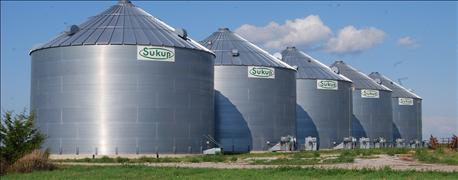May 6, 2016

With tighter farmer holding of old crop grain, good weather to produce 2016 crops and continued low cash prices, this situation could trigger the need to consider adding more on-farm storage bins. Where would you store a big 2016 crop?
Several farmers have already asked about resources on Iowa State University’s Ag Decision Maker website, as they seek help in answering the question: Should we build more grain storage on our farm?
There are some good reasons for building more on-farm grain storage capacity. They include:
1) Improved harvest efficiency to match a farm’s transportation and labor
2) Reduced corn drying and shrink costs
3) Capturing futures carry by holding bushels into postharvest
4) Improved basis (cash minus nearby futures) into postharvest
5) Spreading cash sales and grain delivery with available transportation and labor
Grain prices tend to be higher later in the marketing year
Many farmers use on-farm storage to hold bushels until the winter, spring or early summer months. This is when they may benefit from a seasonal trend of higher futures prices and improved basis opportunities. On average over the past 15 years, farmers storing corn for roughly six months after harvest could gain a net return of about 25 cents per bushel compared to selling at harvest and avoiding storage costs.
For soybeans, the net return for storing six months after harvest has been roughly 60 to 80 cents per bushel compared to selling at harvest and avoiding storage costs. However, for soybeans, many of those 15 years were years that U.S. soybean exports were increasing rapidly. Now, South American soybeans fill much of that demand during the spring and summer.
Looking at the current U.S. grain stocks forecast for the end of August 2016, it’s evident that farmers will likely be storing more bushels than they have in over 10 years. However, don’t add more storage bins as a substitute for improving your marketing skills or trying to speculate on futures prices longer.
On-farm grain storage allows you to take advantage of markets
Some farmers will build more storage this summer as they continue to hold portions of their 2014 and 2015 crops, especially corn. Many of those same farms likely don’t have plans for marketing their 2016 crop. Given the current farm financial situation, it may be difficult to justify the use of a farm’s precious working capital or to justify increasing the debt load to store grain for multiple years. Some lenders might not approve lending money to build more grain storage to hold multiple years of grain without adequate repayment capacity in addition to a marketing plan.
Many farmers have learned to use marketing tools such as forward cash and basis contracts in addition to minimum price contracts to avoid accruing storage and interest costs. This reduces the risks of futures prices and/or a wider basis and avoids the need for building more storage. Recognize that a lot of on-farm storage was built in recent years, not necessarily because of large crops. Some farmers were looking for a fast write-off of depreciable assets to reduce income taxes. With tight profit margins for 2016, not a lot of farmers are looking for tax savings in addition to accumulating even more farm debt.
Final thought: Your choice of grain storage options will depend on the relative cost of each and how it fits into your overall harvesting, handling and marketing system. Some additional resources that can help you decide whether or not to build a bin can be found on the following websites.
Additional resources
* “Grain Storage Investment Comparison.” Iowa State University Extension and Outreach Ag Decision Maker File A2-35 Decision Tool.
* “Condominium Grain Storage.” Iowa State University Ag Decision Maker file A2-36.
* “Cost of Storing Grain.” Iowa State University Ag Decision Maker file A2-33.
* “The Economics of On-Farm Storage.” MF-2474, Kansas State University Extension. 2007.
* “Grain Drying, Handling and Storage Handbook.” MWPS-13, Midwest Plan Service, Iowa State University. 1988.
* “Grain Drying and Storage Publications.” North Dakota State University.
* “On-Farm Grain Storage Costs: Consider All the Factors.” University of Minnesota.
For farm management information and analysis visit ISU's Ag Decision Maker site extension.iastate.edu/agdm; ISU Extension farm management specialist Steve Johnson's site is at extension.iastate.edu/polk/farm-management.
You May Also Like




